2014 VOLKSWAGEN TOUAREG seats
[x] Cancel search: seatsPage 92 of 620

Assigning driver seat and outside mirror settings to a vehicle key
The memory function of all vehicle keys is disabled when the vehicle is first delivered from the factory.
To enable vehicle key memory function:
�x Unlock the driver door.
�x Press and hold a memory button until memory position is reached.
�x Press and hold the unlock button �0 on the vehicle key and then press the desired memory button at the same time within about 3 seconds. A chime sounds to confirm activation.
To disable vehicle key memory function:
�x Press and hold the �3�%�4 button.
�x Press and hold the unlock button �0 on the vehicle key and the desired memory button at the same time within about 10 seconds. A chime sounds to confirm deactivation.
Assigning settings to an additional vehicle key
�x Follow the instructions ⇒ Assigning memory seat settings to the remote control vehicle keys to assign the driver seat and outside mirror settings to the vehicle key.
�x Unlock the vehicle with the same vehicle key.
�x Adjust driver seat and outside mirrors.
�x Lock the vehicle with locking button �1 in the vehicle key to store the settings.
Once the settings are stored, the driver seat and the outside mirrors move to the stored positions whenever the vehicle is unlocked with the �0 button on the vehicle key (or unlocked with the door handle sensor on vehicles with Keyless Access) and the driver door is opened. If 2 people use the vehicle, each of them should always use the key in which his or her personal settings have been stored.
Initializing the memory seats
The memory system must be initialized by an authorized Volkswagen dealer, an authorized Volkswagen Service Facility, or another qualified workshop in certain situations, for instance, if a new driver seat is installed.
Initializing clears all memories and assignments of the memory seats. After that, memory buttons can be reprogrammed and assigned to a vehicle key.
�x Open the driver door but do not enter the vehicle.
�x Adjust the seats from the outside.
�x Move the angle of the backrest forward as far as it will go.
�x Release the backrest adjustment switch and press it again until you hear a chime sound.
Cancellation conditions when storing settings for the memory buttons
When one of the following conditions is met, the storing process will be cancelled:
�x Charging condition of the vehicle battery is weak.
�x Repeated pressing of the SET button within about 10 seconds.
�x Readjustment of the seat position within about 10 seconds after pressing the SET button.
Page 98 of 620
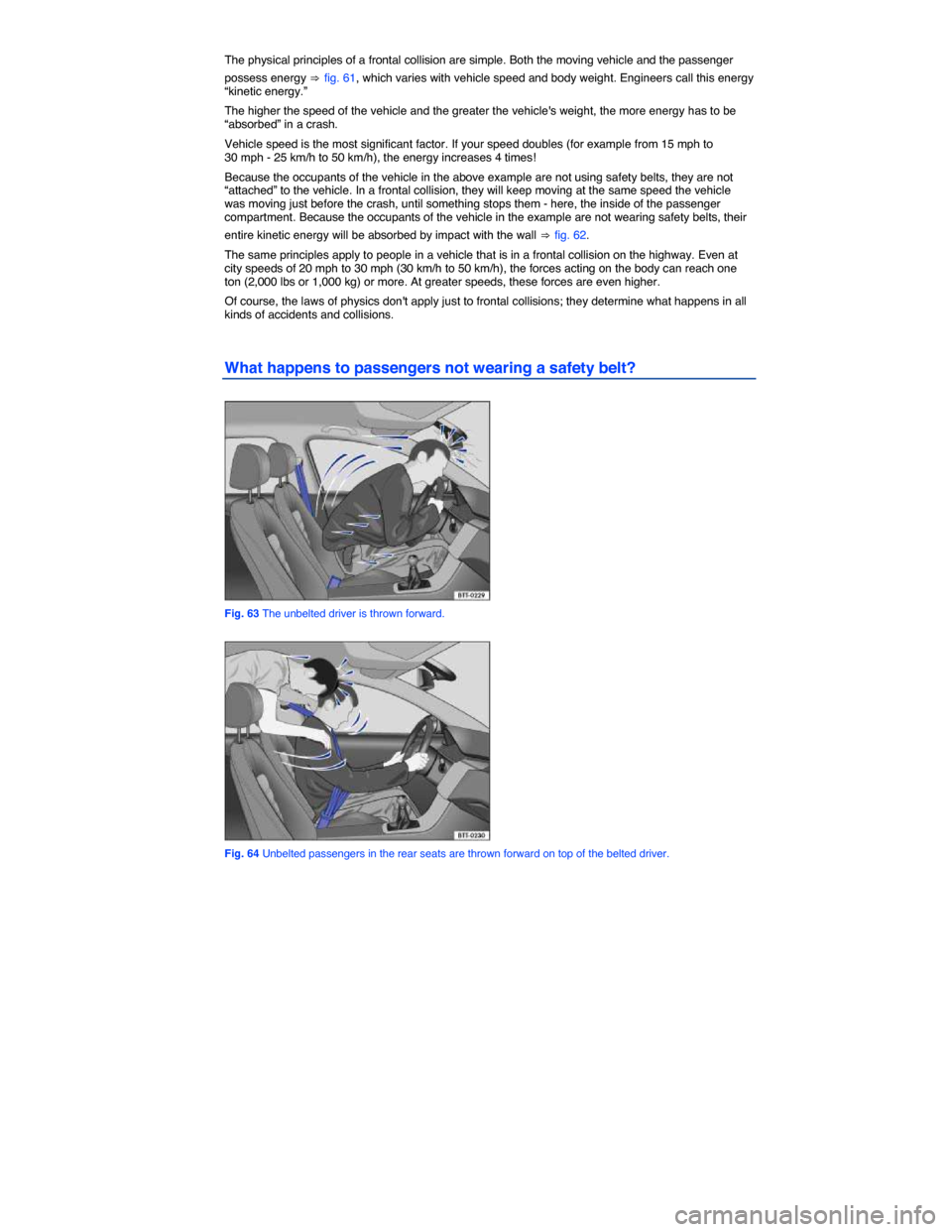
The physical principles of a frontal collision are simple. Both the moving vehicle and the passenger
possess energy ⇒ fig. 61, which varies with vehicle speed and body weight. Engineers call this energy “kinetic energy.”
The higher the speed of the vehicle and the greater the vehicle's weight, the more energy has to be “absorbed” in a crash.
Vehicle speed is the most significant factor. If your speed doubles (for example from 15 mph to 30 mph - 25 km/h to 50 km/h), the energy increases 4 times!
Because the occupants of the vehicle in the above example are not using safety belts, they are not “attached” to the vehicle. In a frontal collision, they will keep moving at the same speed the vehicle was moving just before the crash, until something stops them - here, the inside of the passenger compartment. Because the occupants of the vehicle in the example are not wearing safety belts, their
entire kinetic energy will be absorbed by impact with the wall ⇒ fig. 62.
The same principles apply to people in a vehicle that is in a frontal collision on the highway. Even at city speeds of 20 mph to 30 mph (30 km/h to 50 km/h), the forces acting on the body can reach one ton (2,000 lbs or 1,000 kg) or more. At greater speeds, these forces are even higher.
Of course, the laws of physics don't apply just to frontal collisions; they determine what happens in all kinds of accidents and collisions.
What happens to passengers not wearing a safety belt?
Fig. 63 The unbelted driver is thrown forward.
Fig. 64 Unbelted passengers in the rear seats are thrown forward on top of the belted driver.
Page 104 of 620
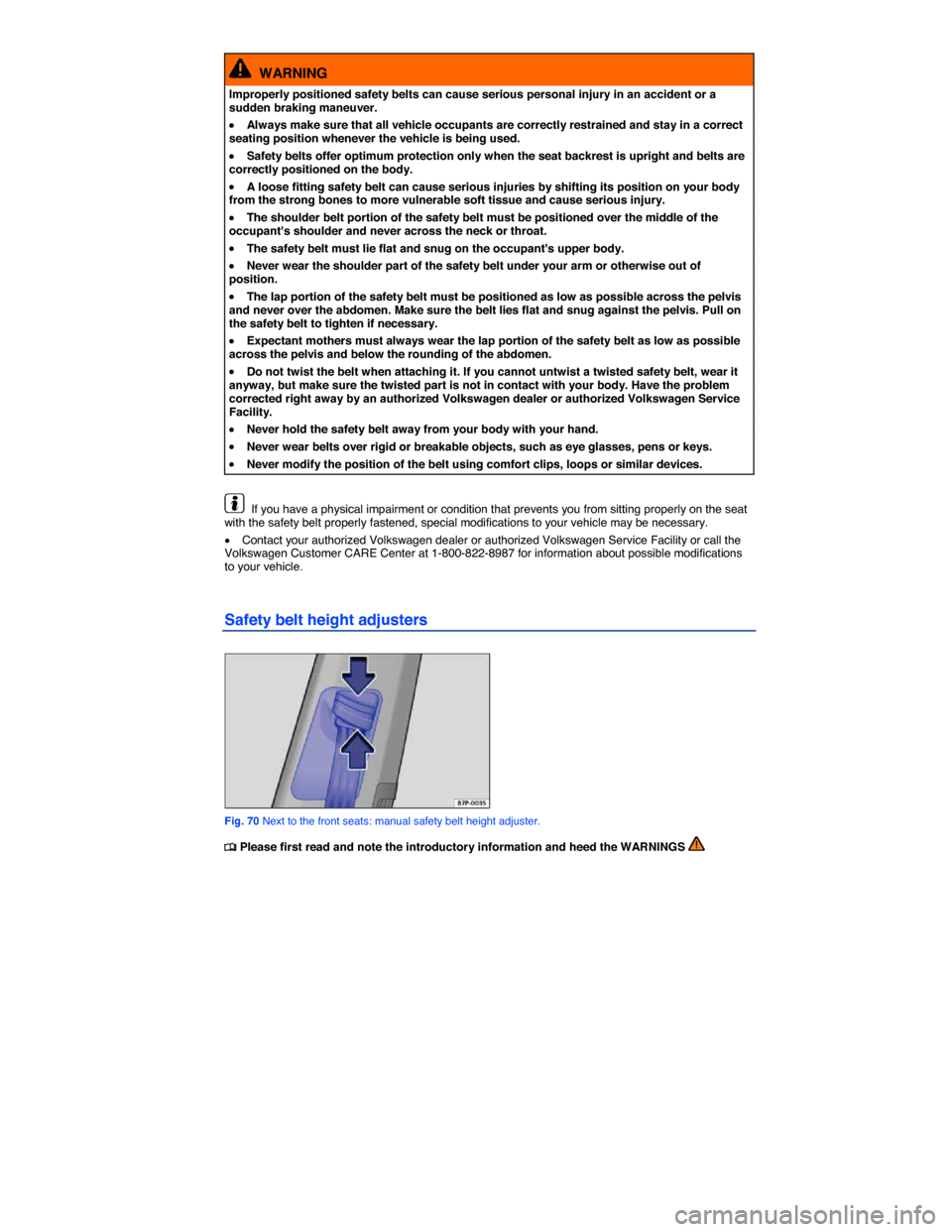
WARNING
Improperly positioned safety belts can cause serious personal injury in an accident or a sudden braking maneuver.
�x Always make sure that all vehicle occupants are correctly restrained and stay in a correct seating position whenever the vehicle is being used.
�x Safety belts offer optimum protection only when the seat backrest is upright and belts are correctly positioned on the body.
�x A loose fitting safety belt can cause serious injuries by shifting its position on your body from the strong bones to more vulnerable soft tissue and cause serious injury.
�x The shoulder belt portion of the safety belt must be positioned over the middle of the occupant's shoulder and never across the neck or throat.
�x The safety belt must lie flat and snug on the occupant's upper body.
�x Never wear the shoulder part of the safety belt under your arm or otherwise out of position.
�x The lap portion of the safety belt must be positioned as low as possible across the pelvis and never over the abdomen. Make sure the belt lies flat and snug against the pelvis. Pull on the safety belt to tighten if necessary.
�x Expectant mothers must always wear the lap portion of the safety belt as low as possible across the pelvis and below the rounding of the abdomen.
�x Do not twist the belt when attaching it. If you cannot untwist a twisted safety belt, wear it anyway, but make sure the twisted part is not in contact with your body. Have the problem corrected right away by an authorized Volkswagen dealer or authorized Volkswagen Service Facility.
�x Never hold the safety belt away from your body with your hand.
�x Never wear belts over rigid or breakable objects, such as eye glasses, pens or keys.
�x Never modify the position of the belt using comfort clips, loops or similar devices.
If you have a physical impairment or condition that prevents you from sitting properly on the seat with the safety belt properly fastened, special modifications to your vehicle may be necessary.
�x Contact your authorized Volkswagen dealer or authorized Volkswagen Service Facility or call the Volkswagen Customer CARE Center at 1-800-822-8987 for information about possible modifications to your vehicle.
Safety belt height adjusters
Fig. 70 Next to the front seats: manual safety belt height adjuster.
�
Page 105 of 620
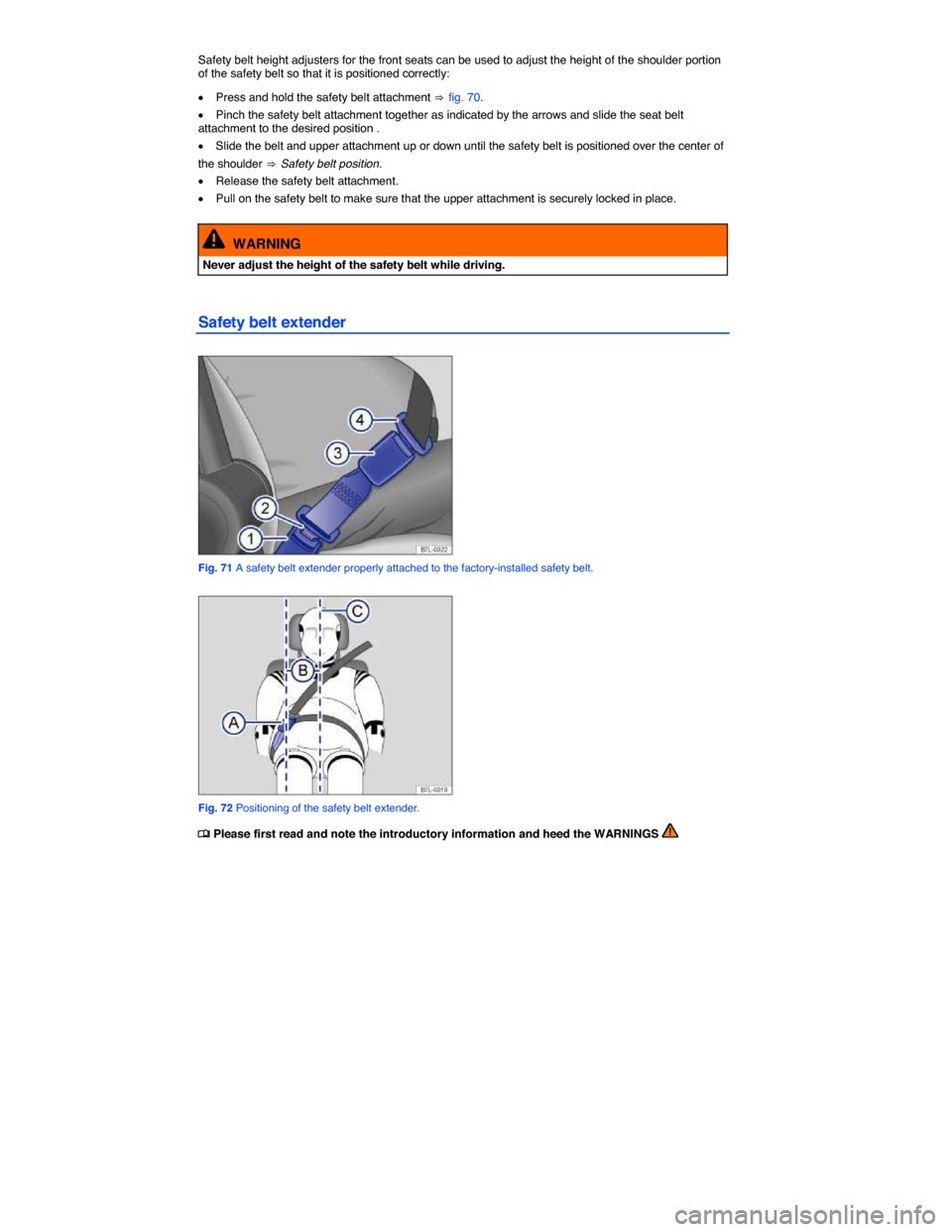
Safety belt height adjusters for the front seats can be used to adjust the height of the shoulder portion of the safety belt so that it is positioned correctly:
�x Press and hold the safety belt attachment ⇒ fig. 70.
�x Pinch the safety belt attachment together as indicated by the arrows and slide the seat belt attachment to the desired position .
�x Slide the belt and upper attachment up or down until the safety belt is positioned over the center of
the shoulder ⇒ Safety belt position.
�x Release the safety belt attachment.
�x Pull on the safety belt to make sure that the upper attachment is securely locked in place.
WARNING
Never adjust the height of the safety belt while driving.
Safety belt extender
Fig. 71 A safety belt extender properly attached to the factory-installed safety belt.
Fig. 72 Positioning of the safety belt extender.
�
Page 144 of 620
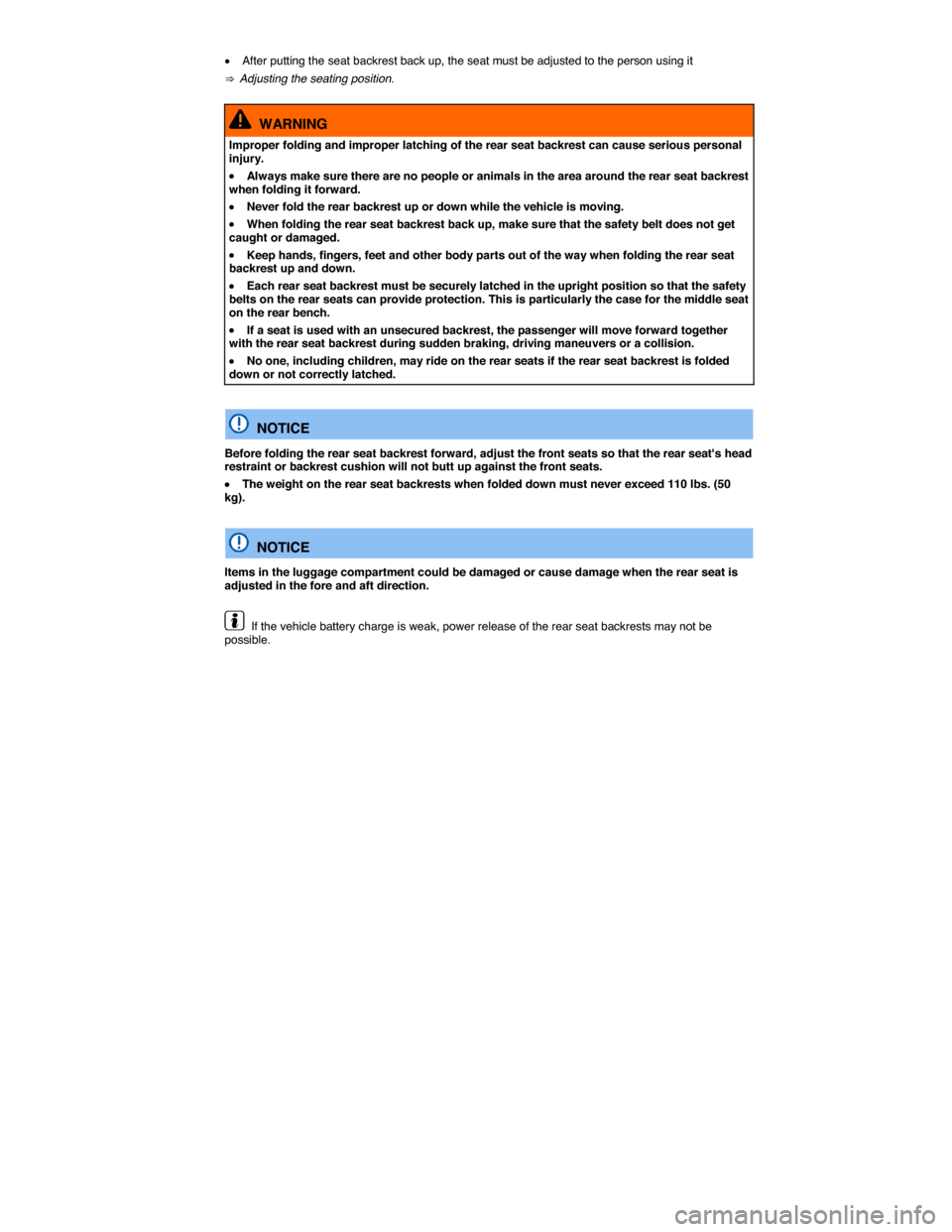
�x After putting the seat backrest back up, the seat must be adjusted to the person using it
⇒ Adjusting the seating position.
WARNING
Improper folding and improper latching of the rear seat backrest can cause serious personal injury.
�x Always make sure there are no people or animals in the area around the rear seat backrest when folding it forward.
�x Never fold the rear backrest up or down while the vehicle is moving.
�x When folding the rear seat backrest back up, make sure that the safety belt does not get caught or damaged.
�x Keep hands, fingers, feet and other body parts out of the way when folding the rear seat backrest up and down.
�x Each rear seat backrest must be securely latched in the upright position so that the safety belts on the rear seats can provide protection. This is particularly the case for the middle seat on the rear bench.
�x If a seat is used with an unsecured backrest, the passenger will move forward together with the rear seat backrest during sudden braking, driving maneuvers or a collision.
�x No one, including children, may ride on the rear seats if the rear seat backrest is folded down or not correctly latched.
NOTICE
Before folding the rear seat backrest forward, adjust the front seats so that the rear seat's head restraint or backrest cushion will not butt up against the front seats.
�x The weight on the rear seat backrests when folded down must never exceed 110 lbs. (50 kg).
NOTICE
Items in the luggage compartment could be damaged or cause damage when the rear seat is adjusted in the fore and aft direction.
If the vehicle battery charge is weak, power release of the rear seat backrests may not be possible.
Page 151 of 620

WARNING
During hard braking or an accident, loose objects can fly through the passenger compartment and cause serious or even fatal injuries.
�x Even if the luggage compartment floor panel is properly raised, it is still necessary to secure all objects.
�x Objects stowed between the rear seat bench and the luggage compartment floor panel must never be more than 2/3 as high as the raised floor panel.
�x Objects stowed between the rear seat bench and the raised luggage compartment floor panel must never weigh more than about 16.5 lbs. (7.5 kg).
If you slide the rear seats forward, there is a gap between the luggage compartment floor and the rear seats. Make certain there are no objects in this space before sliding the rear seats back again.
Page 203 of 620

WARNING
Some kinds of cigarette lighters can be lit unintentionally, or crushed causing a fire that can result in serious burns and vehicle damage.
�x Always make sure that there are no lighters in the seat tracks or near other moving parts before adjusting the seats.
�x Before closing a storage compartment, always make sure that no cigarette lighter can be activated, crushed, or otherwise damaged.
�x Never leave a cigarette lighter in a storage compartment, on the instrument panel or in other places in the vehicle. Heat buildup in the passenger and luggage compartment of a parked vehicle can result in temperatures in the vehicle that are much higher than the outside temperatures, particularly in summer. High temperatures could cause the cigarette lighter to catch fire.
NOTICE
�x The defroster heating wires or antenna in the rear window can be damaged by hard or sharp things on the shelf below the rear window.
�x Do not keep any food, medicine, or other items sensitive to heat or cold in the vehicle. They can be damaged or made unusable by heat or cold.
�x Things that are made of transparent materials (such as eyeglasses, magnifying glasses, or transparent suction cups on the windows) can magnify sunlight and damage the vehicle.
The ventilation slots between the rear window and the luggage compartment cover must not be blocked so that stale air can escape from the vehicle.
Storage compartment in the driver door
Fig. 119 In the driver door: Storage compartment.
�
Page 208 of 620
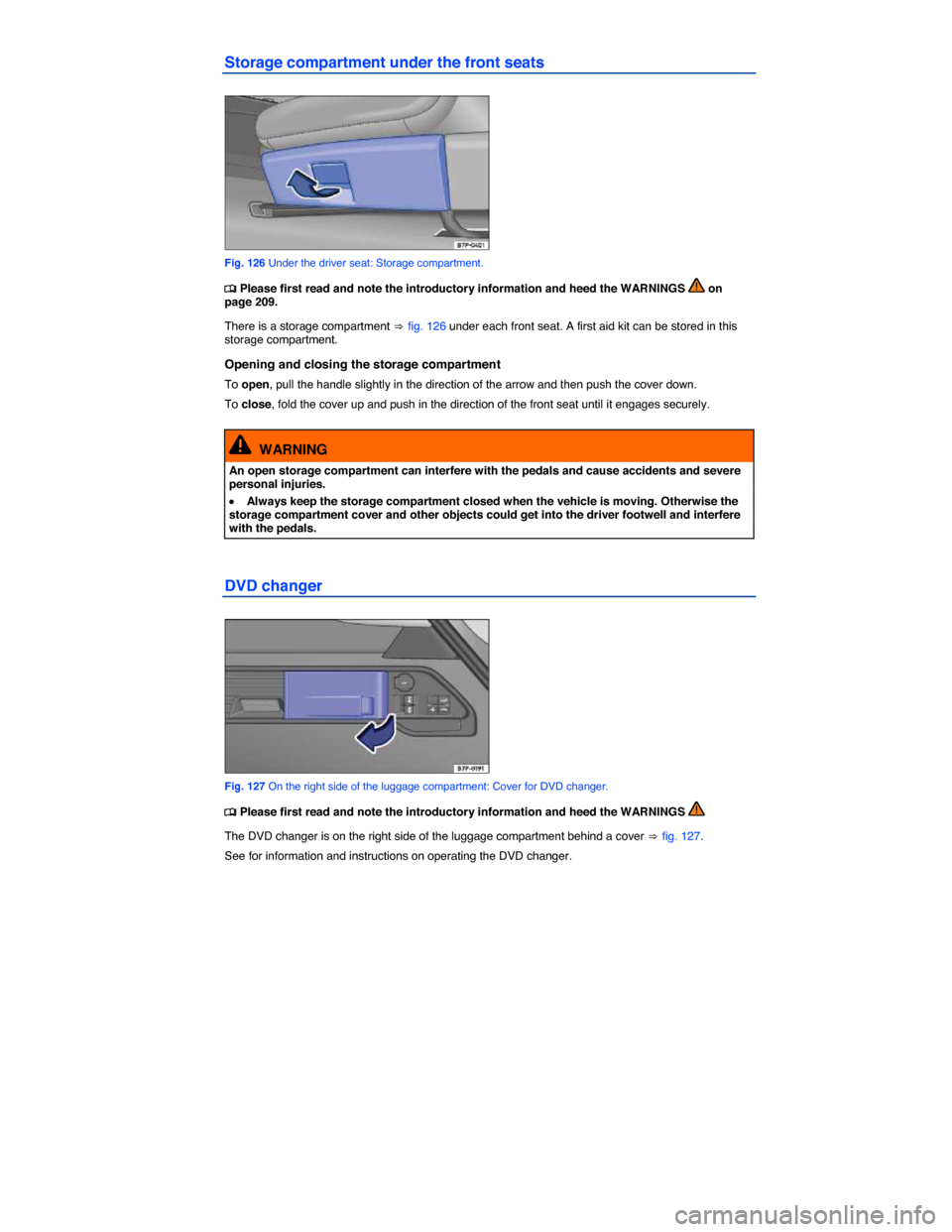
Storage compartment under the front seats
Fig. 126 Under the driver seat: Storage compartment.
�